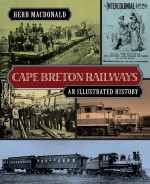Cape Breton Railways: An Illustrated History
Available in many bookstores and on-line. International customers can find the book on Amazon (ANZO: thenile.com.au)
Shortlisted for the 2013 Evelyn Richardson Prize for Non-fiction (Writers’ Federation of Nova Scotia)
Now available as an E-book
CAPE BRETON’S RAIL LINES are perhaps best known for their substantial roles in the coal and steel industries—and their decline as those industries faded away. Yet, despite their prominent connections to coal and steel, railways played many other important roles in the life of the Island.
For more than a hundred years, railways carried people to and from Cape Breton as well as between communities on the island. Railways carried the mail; before the development of the telephone system, the railway companies provided telegraph service for occasions when the mail was too slow; railways moved freight and express for individuals and businesses; and the railways provided jobs, in large numbers, directly to their own employees and indirectly through companies whose products and services they used.
The first horse-powered line at Sydney Mines is a contender for recognition as the first railway in Canada. The case for that honour requires a definition of “railway” based on a long-run sense of history—but any serious look at railways calls for a long-run view.
In 1829, only four years after the opening of the Stockton and Darlington in County Durham, England, the railway age came to Cape Breton. The first lines on the island used horse-power for more than two decades. Steam locomotives did not arrive until 1853. The early Cape Breton experience was a direct transfer of early English technology, but what had happened in England over the course of two hundred years occurred on Cape Breton within the span of twenty-five years.
Cape Breton’s railways were shaped by factors such physical geography, availability of both capital and customers, and the distribution of population and industries. In response to those factors, railway builders and operators often had to make difficult choices and try to deal with factors they could not control.
Over a century-and-a-half, as some areas of Cape Breton evolved from a rural and agricultural society into an urban and industrial one, railways played a central role in supporting the changes that took place. This book looks at the Island’s railways in the contexts of economic, political and social developments on and beyond Cape Breton. As visual support, Herb MacDonald has selected a rich arrray of photographs, drawings, maps, documents and artifacts to illustrate the themes and events within the Island’s railway history.






